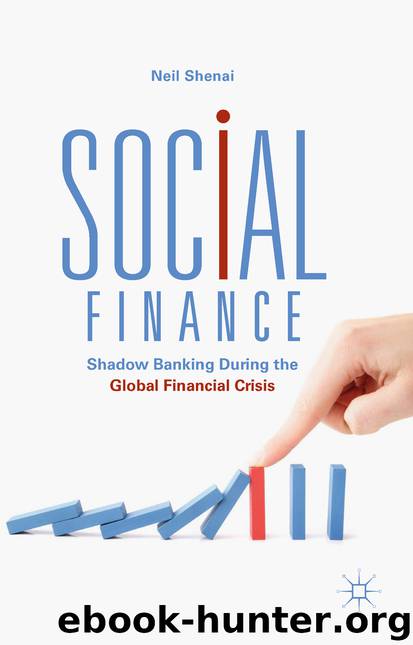Social Finance by Neil Shenai

Author:Neil Shenai
Language: eng
Format: epub
ISBN: 9783319913469
Publisher: Springer International Publishing
Bond Ratings and the Creation of Information Insensitive Debt
In January 2011, the Financial Crisis Inquiry Commission (FCIC) issued a report summarizing the results into their investigation of the primary causes of the global financial crisis. While there was some dissent among the Commission about the crisis’ primary causes, the Commission agreed that the credit rating agencies (CRAs) were “essential cogs in the wheel of financial destruction” prior to the crisis. The report found that investors would rely on ratings “often blindly” and concluded that the global financial crisis “could not have happened without the rating agencies” (The Financial Crisis Inquiry Commission 2011, xxv).
Why did investors “blindly” rely on credit ratings? How did the three independent CRAs—Moody’s, Standard and Poor’s, and Fitch—become “key enablers” of America’s real estate bubble and credit boom? What led the bipartisan FCIC to conclude the CRAs were decisive factors that enabled the unsustainable increase in real estate prices and related credit boom, such that ratings were necessary preconditions for the global financial crisis? Why did CRAs face incentives to grant high ratings to in hindsight risky ABS? And what do ratings tell us about the role of economic conventions in financial markets?
All credit markets suffer from information asymmetries—in general, borrowers know more about their ability to repay than lenders. In extreme cases, this information asymmetry can cause adverse selection problems in financial markets, wherein the least creditworthy borrowers crowd out the most creditworthy, leading to foregone Pareto-optimal transactions and market failure (Akerlof 1970). One way to solve this market failure is for borrowers to enlist third parties to render independent judgments on their creditworthiness, based on the rationale that dispassionate observers lack a financial interest in a transaction and can thus be trusted to provide an objective appraisal of a borrower’s ability to repay their loans. The big three CRAs, including Moody’s, Standard and Poor’s, and their European counterpart, Fitch, provided authoritative opinions on the creditworthiness of different borrowers, including sovereign governments, corporations, and ABS, to name a few examples. Ratings satisfied a mutual need in capital markets: creditors valued having third party opinions on the creditworthiness of their borrowers, while debtors found that ratings from the CRAs enhanced their ability to borrow.
Are credit ratings conventions? Moody’s Investors Service defines credit ratings as “credible and independent assessments of credit risk” that “contribute to efficiencies in fixed-income markets and other obligations” (Moody’s Investors Service 2018). Standard & Poor’s (S&P) states that credit ratings are “opinions about credit risk” that describe “the ability and willingness of an issuer…to meet its financial obligations.” They also caution that “credit ratings [are] not an exact science” and just one factor investors ought to consider while making investment decisions (Standard & Poor’s Ratings Services 2014, 2–3).
Based on the rating agencies’ own descriptions, credit ratings qualify as economic conventions of expert opinion . The widespread use of bond ratings shows that market participants and regulators believe that the CRAs have an information advantage that allowed them to render authoritative judgments about borrowers that would otherwise be unattainable by the investor public absent significant due diligence costs.
Download
This site does not store any files on its server. We only index and link to content provided by other sites. Please contact the content providers to delete copyright contents if any and email us, we'll remove relevant links or contents immediately.
Pale Blue Dot by Carl Sagan(4613)
The Rules Do Not Apply by Ariel Levy(4523)
Goodbye Paradise(3446)
Ogilvy on Advertising by David Ogilvy(3327)
Delivering Happiness by Tony Hsieh(3280)
Liar's Poker by Michael Lewis(3221)
Into Thin Air by Jon Krakauer(3129)
Purple Cow by Seth Godin(3069)
Rogue Trader by Leeson Nick(2824)
The Social Psychology of Inequality by Unknown(2762)
The Airbnb Story by Leigh Gallagher(2699)
4 - Harry Potter and the Goblet of Fire by J.K. Rowling(2530)
The Mind Map Book by Tony Buzan(2415)
Bossypants by Tina Fey(2373)
All the President's Men by Carl Bernstein & Bob Woodward(2261)
Claridge's: The Cookbook by Nail Martyn & Erickson Meredith(2257)
Six Billion Shoppers by Porter Erisman(2225)
Master of the Game by Sidney Sheldon(2181)
Alibaba by Duncan Clark(1979)
